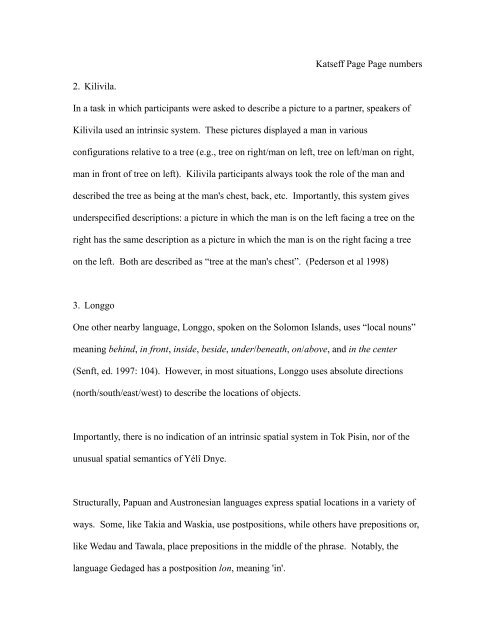The case of pidgin and creole languages - Linguistics
The case of pidgin and creole languages - Linguistics
The case of pidgin and creole languages - Linguistics
You also want an ePaper? Increase the reach of your titles
YUMPU automatically turns print PDFs into web optimized ePapers that Google loves.
2. Kilivila.<br />
Katseff Page Page numbers<br />
In a task in which participants were asked to describe a picture to a partner, speakers <strong>of</strong><br />
Kilivila used an intrinsic system. <strong>The</strong>se pictures displayed a man in various<br />
configurations relative to a tree (e.g., tree on right/man on left, tree on left/man on right,<br />
man in front <strong>of</strong> tree on left). Kilivila participants always took the role <strong>of</strong> the man <strong>and</strong><br />
described the tree as being at the man's chest, back, etc. Importantly, this system gives<br />
underspecified descriptions: a picture in which the man is on the left facing a tree on the<br />
right has the same description as a picture in which the man is on the right facing a tree<br />
on the left. Both are described as “tree at the man's chest”. (Pederson et al 1998)<br />
3. Longgo<br />
One other nearby language, Longgo, spoken on the Solomon Isl<strong>and</strong>s, uses “local nouns”<br />
meaning behind, in front, inside, beside, under/beneath, on/above, <strong>and</strong> in the center<br />
(Senft, ed. 1997: 104). However, in most situations, Longgo uses absolute directions<br />
(north/south/east/west) to describe the locations <strong>of</strong> objects.<br />
Importantly, there is no indication <strong>of</strong> an intrinsic spatial system in Tok Pisin, nor <strong>of</strong> the<br />
unusual spatial semantics <strong>of</strong> Yélî Dnye.<br />
Structurally, Papuan <strong>and</strong> Austronesian <strong>languages</strong> express spatial locations in a variety <strong>of</strong><br />
ways. Some, like Takia <strong>and</strong> Waskia, use postpositions, while others have prepositions or,<br />
like Wedau <strong>and</strong> Tawala, place prepositions in the middle <strong>of</strong> the phrase. Notably, the<br />
language Gedaged has a postposition lon, meaning 'in'.

















